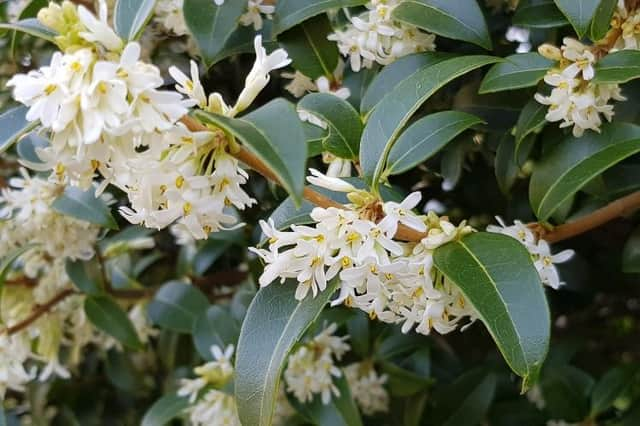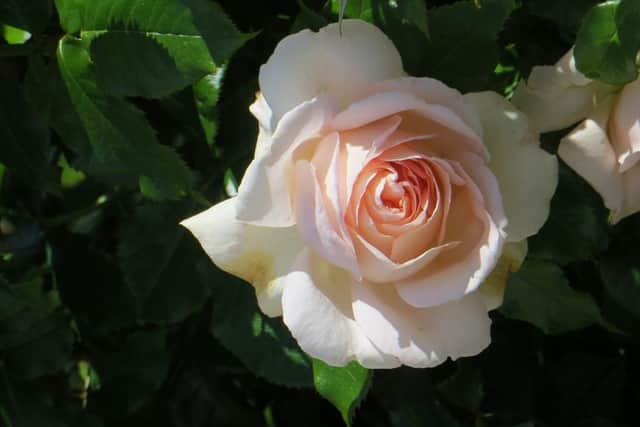Have you got a nose for a fragrant garden?


Some are flamboyantly generous, casting their offering into the morning and evening air, others are more retiring, waiting for the knowing gardener’s approach to reveal their secret. The joy they all bring is inestimable.
We have a trio of a shrubby Osmanthus burkwoodii. They were trained as standards, now 2.5 metres tall, evergreen and currently covered in white scented flowers. I raised them from softwood stem cuttings taken in summer two decades ago and cannot resist propagating more – reference the half dozen or so bushy specimens barely 30cm tall in different parts of the garden. One of the life-size specimens stopped the window cleaner in his tracks last week. I saw him imbibing the aroma and mouthing ‘What’s it called?’
Advertisement
Hide AdAdvertisement
Hide AdSeveral of the summer viburnums are flowering now. They are sweetly scented and our V. juddii never fails to please. The rounded blooms of tennis ball proportion have just appeared. Nearby, the fragrance of an evergreen Mexican orange blossom (Choisya ternata) is also attracting our attention. It’s such a good value for money shrub that blooms in late spring then again as autumn approaches.


We also enjoy the golden-leaved cultivar Sundance, which was planted in a sunny position because shade turns the leaves into a pale green. This variety has a reputation for failing to flower but it performs regularly for us in the full light.
Before too long the lilac (syringa), mock orange (philadelphus), honeysuckle (lonicera) and other trusty shrubs will be making their contribution to the scented summer air, and you too could be enjoying a bit of this action. Secure the pot-grown specimen of your choice at the local garden centre and there’s an option to plant in the open or transfer it to a special container where, with care, it will last for years.
Roses play a huge part in our summer displays, and fragrance, form, vigour, continuity of bloom are high among my criteria when selecting from the countless cultivars available. This said, we’ve just bought another Chandos Beauty (fully double, pale pink flowers) which comes in bush, climbing or standard form. Why so? Because it’s gorgeous, delivering on all fronts.
A gardener’s scents and sensibilities
Advertisement
Hide AdAdvertisement
Hide AdDon’t judge a book by the cover! A visiting acquaintance once asked why I was growing a vigorous, thorn-laden rose in the garden.
In fairness, it did look rather wild with a few tiny, single rose-pink flowers, so I encouraged him to rub a cluster of young leaves between finger and thumb. Suddenly my ‘wild dogrose’ turned into something special as he imbibed the ripe apple fragrance and smiled.
I’ve seen this same sweetbriar, Rosa eglanteria used effectively as a solid boundary hedge and remain happy with it in the garden. Easily raised from hardwood stem cuttings, it’s just had the severe annual prune.
Borage (Borago officinalis) is an annual herb whose blue flowers were depicted in medieval tapestries. Buy one packet of seed and you have it for life is my experience because seedlings spring up annually but are easily controlled. Bees love it and according to research it constantly replenishes the nectar supply. I like the secret its rugged leaves hold. Rub them and enjoy the cucumber fragrance.
Advertisement
Hide AdAdvertisement
Hide AdWe’ve grown lemon verbena (Aloysia citriodora) in a large pot through several winters but always root softwood stem cuttings as back-up because the leaves have an irresistible citrus fragrance. Helichrysum serotinum secures a place in the ornamental border because the silvery grey leaves and yellow, button-like flowers are attractive. It’s commonly called the curry plant because that’s the strong fragrance that emerges when the leaves are bruised.
Many of the herbs we grow for kitchen use have a predictable fragrance, one that is easily recognised. This can be used to advantage in the garden if they are planted close to pathways. I cannot walk past the Rosemary ‘Miss Jessopps Upright’ without grabbing a stem, letting it slip through the hand and enjoying the scent!